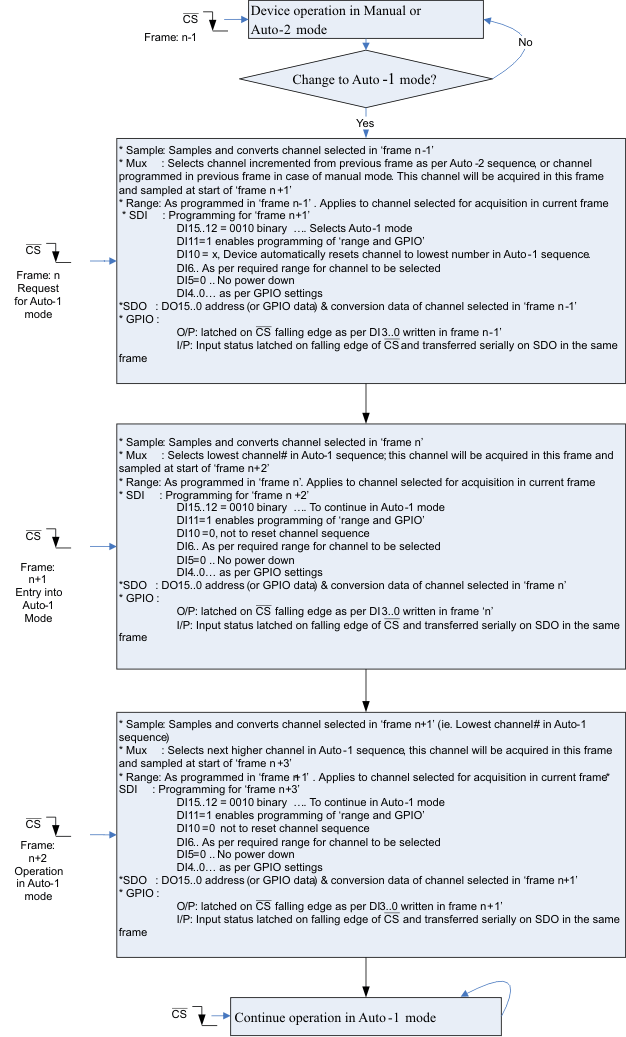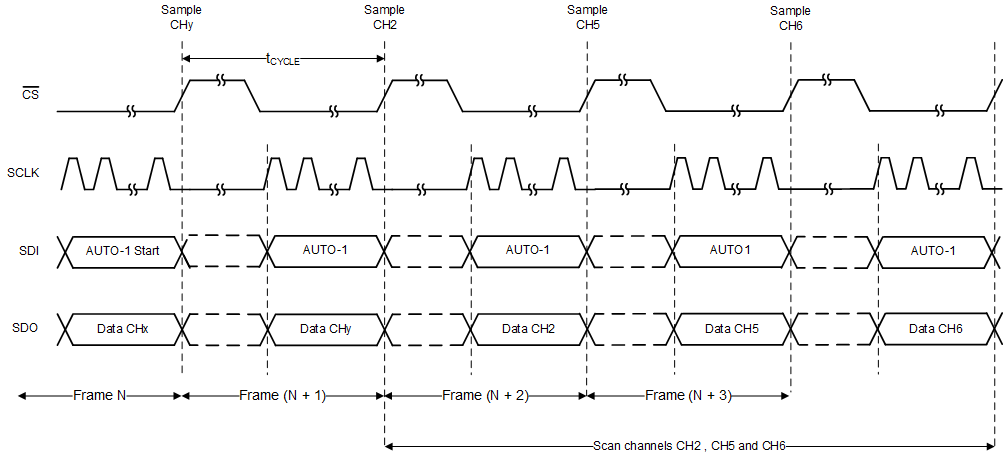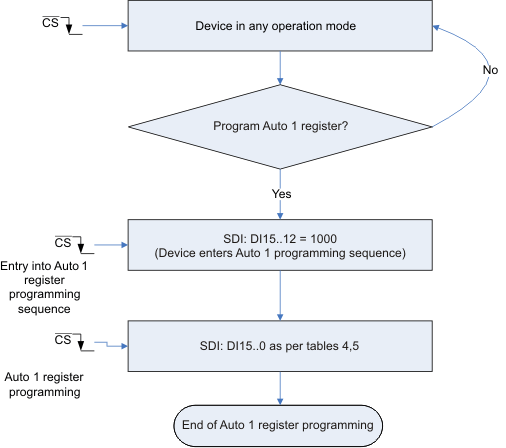SLAS605C June 2008 – July 2018 ADS7950 , ADS7951 , ADS7952 , ADS7953 , ADS7954 , ADS7955 , ADS7956 , ADS7957 , ADS7958 , ADS7959 , ADS7960 , ADS7961
PRODUCTION DATA.
- 1 Features
- 2 Applications
- 3 Description
- 4 Revision History
- 5 Device Comparison Table
- 6 Pin Configuration and Functions
-
7 Specifications
- 7.1 Absolute Maximum Ratings
- 7.2 ESD Ratings
- 7.3 Recommended Operating Conditions
- 7.4 Thermal Information: TSSOP
- 7.5 Thermal Information: VQFN
- 7.6 Electrical Characteristics: ADS7950, ADS7951, ADS7952, ADS7953
- 7.7 Electrical Characteristics, ADS7954, ADS7955, ADS7956, ADS7957
- 7.8 Electrical Characteristics, ADS7958, ADS7959, ADS7960, ADS7961
- 7.9 Timing Requirements
- 7.10 Typical Characteristics (All ADS79xx Family Devices)
- 7.11 Typical Characteristics (12-Bit Devices Only)
- 7.12 Typical Characteristics (12-Bit Devices Only)
- 8 Detailed Description
- 9 Application and Implementation
- 10Power Supply Recommendations
- 11Layout
- 12Device and Documentation Support
- 13Mechanical, Packaging, and Orderable Information
Package Options
Refer to the PDF data sheet for device specific package drawings
Mechanical Data (Package|Pins)
- RGE|24
- DBT|30
Thermal pad, mechanical data (Package|Pins)
- RGE|24
Orderable Information
8.4.5 Operating in Auto-1 Mode
Figure 52 illustrates the steps involved in entering and operating in Auto-1 Channel Sequencing mode. Table 2 lists the Mode Control Register settings for Auto-1 mode.
 Figure 52. Entering and Running in Auto-1 Channel Sequencing Mode
Figure 52. Entering and Running in Auto-1 Channel Sequencing Mode Consider a case where Auto-1 mode is selected to scan channels 2 (CH2), 5 (CH5), and 6 (CH6) as represented in Figure 53. The program register for Auto-1 mode must be programmed as described in Figure 53 before entering into this auto sequencing mode. The device enters into Auto-1 mode on receiving the Auto-1 mode command in the Nth frame. This step causes the device to find the first enabled channel in ascending order and switch the MUX for CH2 in the (N+1)th frame. In the (N+2)th frame, the ADC samples the signal on CH2, shifts out the conversion results, and the MUX also internally switches to CH5. In the (N+3)th frame, the ADC samples and shifts out the conversion result for CH5 and the MUX also internally switches to CH6. This process repeats until the last enabled channel is reached, in which case the process loops back to the first enabled channel. Entering Auto-1 mode from any other mode also causes the device to restart from the first enabled channel. However, modifying the contents of the Auto-1 mode program register while operating in Auto-1 mode causes the device to scan for the next enabled channel.
 Figure 53. Example Auto-1 Mode Timing Diagram
Figure 53. Example Auto-1 Mode Timing Diagram Table 2. Mode Control Register Settings for Auto-1 Mode
| BITS | RESET STATE | LOGIC STATE | FUNCTION | |||
|---|---|---|---|---|---|---|
| DI15-12 | 0001 | 0010 | Selects Auto-1 Mode | |||
| DI11 | 0 | 1 | Enables programming of bits DI10-00. | |||
| 0 | Device retains values of DI10-00 from previous frame. | |||||
| DI10 | 0 | 1 | The channel counter is reset to the lowest programmed channel in the Auto-1 Program Register | |||
| 0 | The channel counter increments every conversion (No reset) | |||||
| DI09-07 | 000 | xxx | Do not care | |||
| DI06 | 0 | 0 | Selects 0 to VREF input range (Range 1) | |||
| 1 | Selects 0 to 2xVREF input range (Range 2) | |||||
| DI05 | 0 | 0 | Device normal operation (no powerdown) | |||
| 1 | Device powers down on the 16th SCLK falling edge | |||||
| DI04 | 0 | 0 | SDO outputs current channel address of the channel on DO15..12 followed by 12-bit conversion result on DO11..00. | |||
| 1 | GPIO3-GPIO0 data (both input and output) is mapped onto DO15-DO12 in the order shown below. Lower data bits DO11-DO00 represent 12-bit conversion result of the current channel. | |||||
| DO15 | DO14 | DO13 | DO12 | |||
| GPIO3(1) | GPIO2(1) | GPIO1(1) | GPIO0(1) | |||
| DI03-00 | 0000 | GPIO data for the channels configured as output. Device will ignore the data for the channel which is configured as input. SDI bit and corresponding GPIO information is given below | ||||
| DI03 | DI02 | DI01 | DI00 | |||
| GPIO3(1) | GPIO2(1) | GPIO1(1) | GPIO0(1) | |||
The Auto-1 Program Register is programmed (once on powerup or reset) to pre-select the channels for the Auto-1 sequence. Auto-1 Program Register programming requires two CS frames for complete programming. In the first CS frame the device enters the Auto-1 register programming sequence and in the second frame it programs the Auto-1 Program Register. Refer to Table 2, Table 3, and Table 4 for complete details.

NOTE:
The device continues its operation in selected mode during programming. SDO is valid, however it is not possible to change the range or write GPIO data into the device during programming.Table 3. Program Register Settings for Auto-1 Mode
| BITS | RESET STATE | LOGIC STATE | FUNCTION |
|---|---|---|---|
| FRAME 1 | |||
| DI15-12 | NA | 1000 | Device enters Auto-1 program sequence. Device programming is done in the next frame. |
| DI11-00 | NA | Do not care | |
| FRAME 2 | |||
| DI15-00 | All 1s | 1 (individual bit) | A particular channel is programmed to be selected in the channel scanning sequence. The channel numbers are mapped one-to-one with respect to the SDI bits; for example,
DI15 → Ch15, DI14 → Ch14 … DI00 → Ch00 |
| 0 (individual bit) | A particular channel is programmed to be skipped in the channel scanning sequence. The channel numbers are mapped one-to-one with respect to the SDI bits; for example
DI15 → Ch15, DI14 → Ch14 … DI00 → Ch00 |
||
Table 4. Mapping of Channels to SDI Bits for 16, 12, 8, 4 Channel Devices
| Device(1) | SDI BITS | |||||||||||||||
|---|---|---|---|---|---|---|---|---|---|---|---|---|---|---|---|---|
| DI15 | DI14 | DI13 | DI12 | DI11 | DI10 | DI09 | DI08 | DI07 | DI06 | DI05 | DI04 | DI03 | DI02 | DI01 | DI00 | |
| 16 Chan | 1/0 | 1/0 | 1/0 | 1/0 | 1/0 | 1/0 | 1/0 | 1/0 | 1/0 | 1/0 | 1/0 | 1/0 | 1/0 | 1/0 | 1/0 | 1/0 |
| 12 Chan | X | X | X | X | 1/0 | 1/0 | 1/0 | 1/0 | 1/0 | 1/0 | 1/0 | 1/0 | 1/0 | 1/0 | 1/0 | 1/0 |
| 8 Chan | X | X | X | X | X | X | X | X | 1/0 | 1/0 | 1/0 | 1/0 | 1/0 | 1/0 | 1/0 | 1/0 |
| 4 Chan | X | X | X | X | X | X | X | X | X | X | X | X | 1/0 | 1/0 | 1/0 | 1/0 |